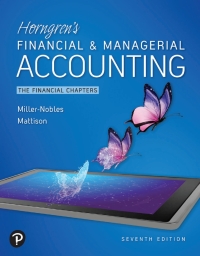Answered step by step
Verified Expert Solution
Question
1 Approved Answer
Correction : Conversion cost RM 500.00 Question 2 a) Explain the rationale of using predetermined overhead rates instead of actual manufacturing overhead rates to apply

Correction : Conversion cost RM 500.00
Question 2 a) Explain the rationale of using predetermined overhead rates instead of actual manufacturing overhead rates to apply manufacturing overhead costs to jobs. (4 marks) b) Saliha Sdn Bhd uses a job-order costing system. The company applies manufacturing overhead to jobs using a predetermined overhead rate based on direct labour-hours. Last year, manufacturing overhead and direct labour-hours were estimated at RM80,000 and 16,000 hours respectively, for the year. In June, Job 500 was completed. Materials costs on the job totalled RM1,500 and labour costs totalled RM2.400 at RM6 per hour. At the end of the year, it was determined that the company worked 15,000 direct labour-hours for the year, and incurred RM78,000 in actual manufacturing overhead costs. Required: 1) Determine the predetermined overhead rate for the year. (2 marks) in) Determine the amount of overhead charged to jobs during the year.(2 marks) 1) Determine the amount of under-applied or over-applied overhead for the year.(2 marks) iv) Assuming that 100 units were completed, determine the unit cost that would appear on the job cost sheet for Job #500. (4 marks) v) Will there be any significant difference in the product cost if plantwide rate based on machine hour were being used. Justify your answer. (4 marks) (c) Scribners Corporation produces fine papers in three production departments -Pulping, Drying, and Finishing. In the Pulping Department, raw materials such as wood fiber and rag cotton are mechanically and chemically treated to separate their fibers. The result is a thick slurry of fibers. In the Drying Department, the wet fibers transferred from the Pulping Department are laid down on porous webs, pressed to remove excess liquid, and dried in ovens. In the Finishing Department, the dried paper is coated, cut, and spooled onto reels ACC3208/ Page 3 of 5 The company uses the weighted average method in its process costing system. Data for March for the Drying Department follow Percent Completed Units Materials Conversion Work in process inventory, March 5.000 100% 20% Work in process inventory, March 31 8,000 100% 25% Pulping cost in work in process RM4,800 inventory, March ! RM500 Units transferred to the next 157.00 units production department Material cost added during March RM102.450 Conversion cost added during March RM31,300 No materials are added in the Drying Department. Pulping cost represents the costs of the wet fibers transferred in from the Pulping Department. Wet fiber is processed in the Drying Department in batches; each unit in the above table is a batch and onc batch of wet fibers produces a set amount of dried paper that is passed on to the Finishing Department. The company uses the weighted average method. Required: 1) Compute the equivalent units for March for pulping and conversion (4 marks) ii) Compute the costs per equivalent unit for March for pulping and conversion. (6 marks) Determine the cost of ending work in process inventory and of the units transferred out to the Finishing Department in March (2 marks) (Total: 30 marks)Step by Step Solution
There are 3 Steps involved in it
Step: 1

Get Instant Access to Expert-Tailored Solutions
See step-by-step solutions with expert insights and AI powered tools for academic success
Step: 2

Step: 3

Ace Your Homework with AI
Get the answers you need in no time with our AI-driven, step-by-step assistance
Get Started


